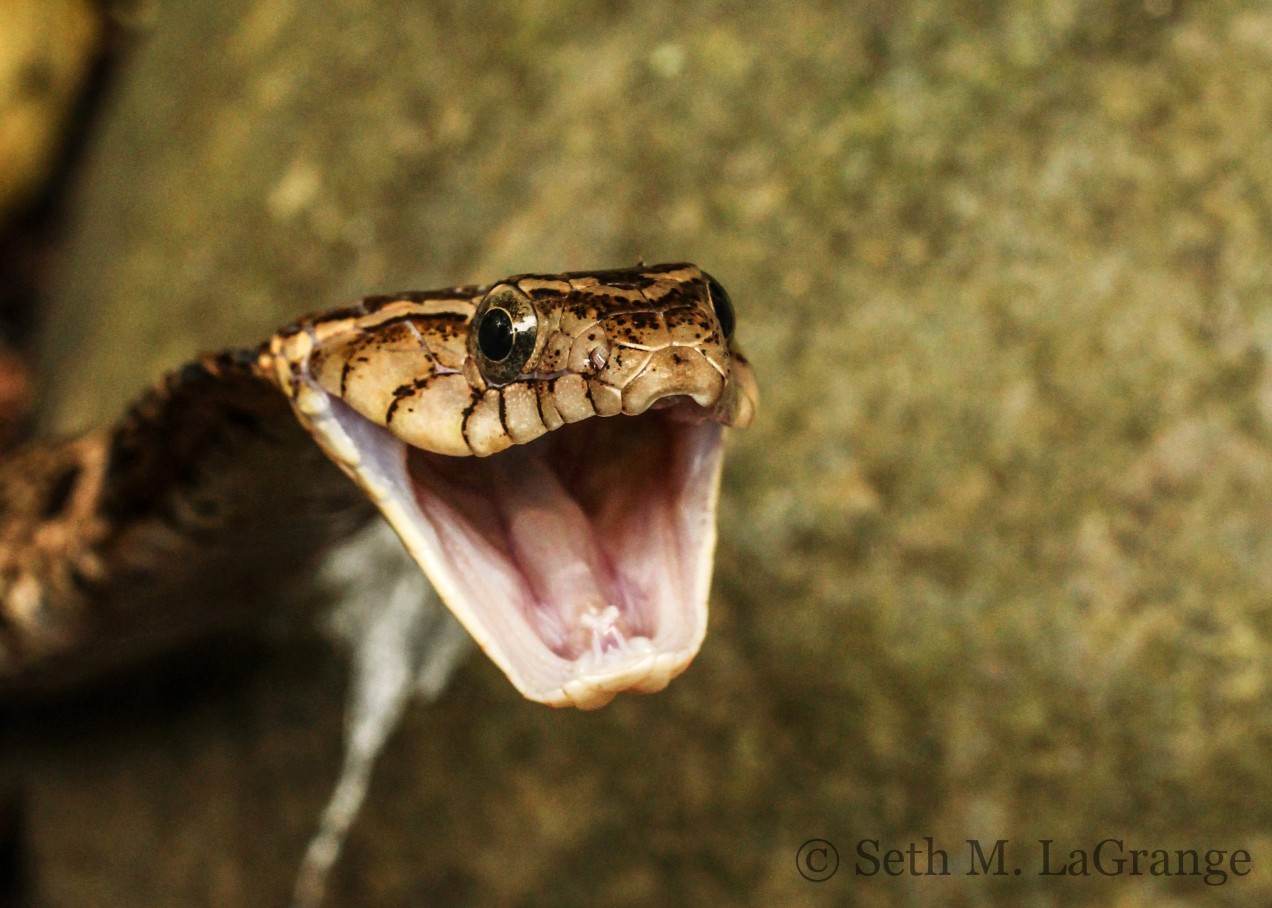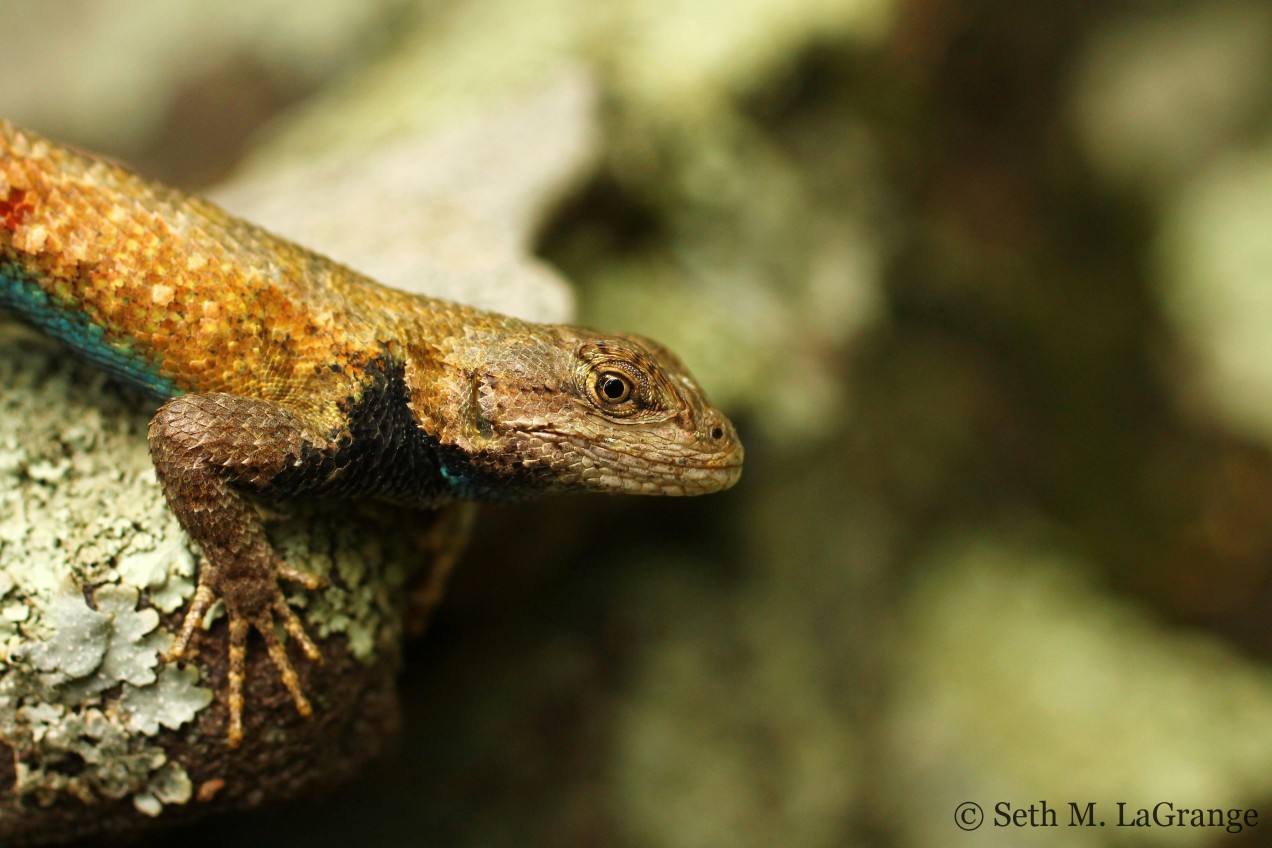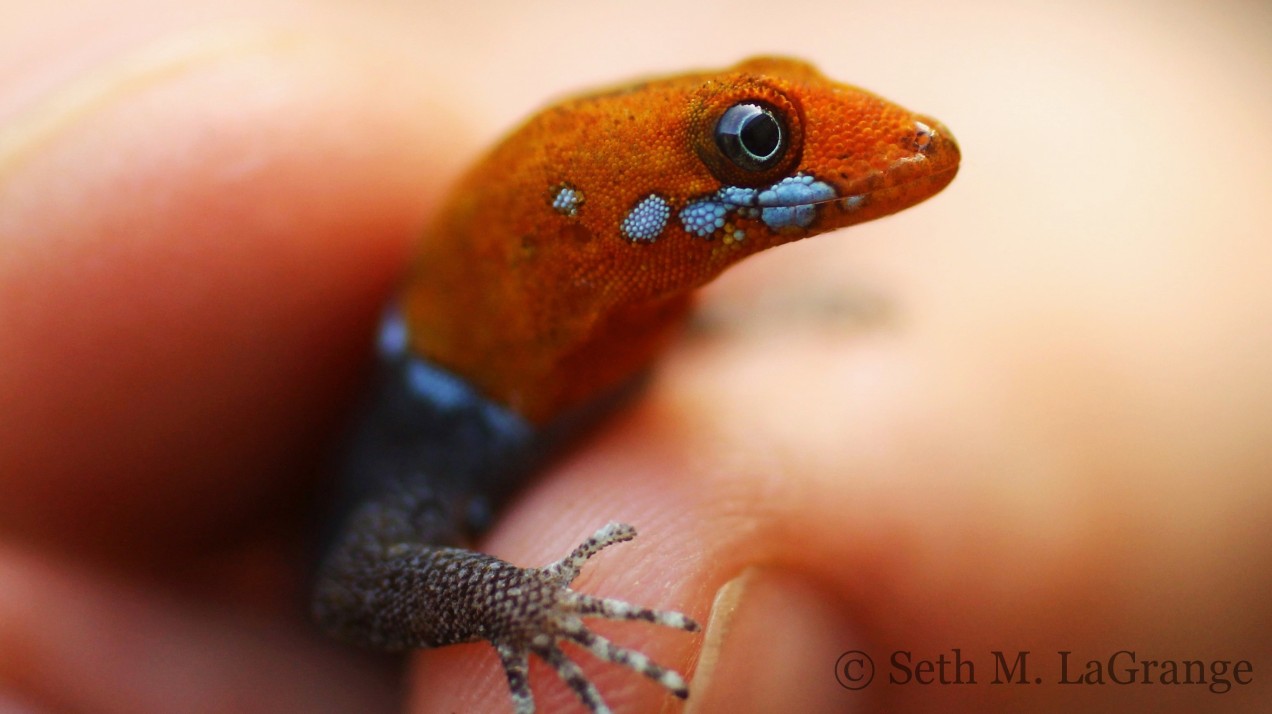
This is a False Fer-De-Lance (Xenodon rabdocephalus) from Costa Rica. It is showing off its defensive posture by flatten out it neck to make it look larger and opening its mouth. This is a rear fanged snake that is mildly venomous.

This is a False Fer-De-Lance (Xenodon rabdocephalus) from Costa Rica. It is showing off its defensive posture by flatten out it neck to make it look larger and opening its mouth. This is a rear fanged snake that is mildly venomous.

This is a photo of an eastern fence lizard (Sceloperus undulatus) from southern Illiois. You can see the bright blue scales on his underbelly indicating that this particular fence lizard is a male. The blue patches become much more apparent during the breeding season.
These are photos of a western cottonmouth (Agkistrodon piscivorus), AKA the water moccasin, from southern Illinois. I actually took these photos at a place locally called “Snake Road” because during the spring and fall you can find many species of snakes migrating across it but more on that in a later post. The western cottonmouth is a venomous pit viper with a stout body reaching approximately 76-107 centimeters in length. these snakes can be quite variable in appearance but most adults are a uniform dark color sometimes with faint traces of bands along their back. These snakes are highly aquatic with a diet consisting mainly of fish however they will also eat other snakes, amphibians, and even small mammals.
The second picture shows a cottonmouth performing its defense mechanism. When these snakes feel threatened they will raise their heads and open their mouths exposing the white flesh within for which this species is named. I assure you this snake is not striking at me. He feels very scared with me so close so he is trying to look very fearsome so that I will leave him alone and while this pose may seem aggressive when I moved away he closed his mouth and continued on his way.
Cottonmouths are often confused with nonvenomous species of water snakes such as the yellow-beillied watersnake (Nerodia erythrogaster flavigaster) above leading to the killing of many completely harmless snakes. An easy way to tell the difference between these snakes when they are in the water is that watersnakes will swim with most of their body under the water with just their head and neck sticking out while a cottonmouth willswim with all or most of its body on top of the water. However, if you see any snake in the water it is best to just let them be and go on your way. They will do the same.

This is a common musk turtle (Sternotherus odoratus) from southern Indiana. These are small turtles ranging in size from 3-5.5 inches. They are strongly aquatic and are mainly carnivorous eating insects, snails, fish, tadpoles, and crayfish as well as some algae and vegetation. They are commonly called stinkpots because of the glands on the plastron that secrete a smelly musk.

This is a yellow headed gecko (Gonatodes albogularis) that I found in Costa Rica. The males of this species sport beautiful colors usually with orange or yellowish heads and blue bodies. females are usually all grey. This is a form of sexual dimorphism. In this case the male is brightly colored to attract a mate.
This is a rough green snake (Opheodrys aestivus) from southern Illinois. These snakes are very hard to spot considering they are a beautiful grass green and as slender as a vine. One of my favorites! Photo Credit: Seth LaGrange
Pictured is a timber rattlesnake (Crotalus horridus). Timber rattlesnakes are one of the most widespread rattlesnakes ranging throughout most of the eastern United States.Photo Credit: Seth LaGrange
I want to start out pretty simple by explaining what exactly reptiles are for those people who may not be sure and those that need a refresher. This post will give a general overview of the history of reptiles, the different kinds of reptiles, and a little bit about their morphology. In subsequent posts I will go into greater detail about each specific kind of reptile.
Herpetology
For starters let’s discuss herpetology. Many people have never heard of this word but it is one that I will use very frequently in the future along with others that I will explain here. Herpetology is the study of reptiles and amphibians and is currently what I am studying in graduate school. Notice that reptiles and amphibians get lumped together within this category even though they are very different. Herpetology comes from the Greek term herpeton which means “creeping animal” and in the scientific community we refer to reptiles and amphibians as herpetofauna. For short we call these animals “herps” and when we go looking for herps we call this “herping” to keep things simple. As I’ve said before, for the purposes of this blog I will focus on reptiles but these terms may still come up.
Reptiles
Reptiles are ectothermic which means that their body temperature changes with their environment. Unlike mammals and birds they do not have the ability to internally regulate their body temperature. They can regulate their temperature by basking in the sun to warm up or sitting in the shade. This is why you do not find many reptiles in very cold regions, however, some have adapted some amazing abilities for dealing with the cold but more on that later. Reptiles have scales covering their body instead of fur or feathers. These scales act as a type of armor for protection and help to prevent water loss. The origin of reptiles is thought to lie somewhere between 310-320 million years ago during the Carboniferous period. These early amniotes were small and lizardlike but still very distinct from modern lizards. During this time tetrapods were still getting used to life on land and reptiles were not the dominant creatures they would later become. It was not until the Mesozoic era that the great radiation of reptiles began. Reptiles would then rule the land for the next 175 million years until their sudden demise at the beginning of the Cenozoic Era approximately 65 million years ago. Some reptiles would survive extinction and become the animals we know today. Reptiles are separated into 4 different groups: Crocodylia, Squamata, Chelonia, and Spenodontia.
Crocodylia
The crocodylia group includes crocodiles, alligators, caiman, and gavials for a total of 25 species. They all have similar body plans with elongated bodies, robust skulls with long snouts and many teeth, thick middles that extend into a thick, powerful tail, and 4 short powerful limbs. All crocodylians are oviparous which means that they lay eggs. The eggs are usually laid in large mounds of vegetation that the female constructs and then guards. There is evidence for some parental care in crocodylians with some species actually tearing open the nest, helping the babies break free of their eggs, and transporting them to the water however not all species have shown this behavior.

American Crocodile (Crocodylus acutus) from Everglades, FL. (Endangered). (Photo credit: Seth M. LaGrange)

American Alligator (Alligator mississippiensis) from Everglades, FL. (Photo credit: Seth M. LaGrange)
Squamata
Squamata includes >6000 lizard species and >2900 snake species for a total of over 9000 species. These are approximate estimates as phylogenies are constantly changing and new species are found everyday with an estimated 168 new species of lizards and snakes found in 2012. I have yet to find an estimate for 2013. Lizards and snakes are probably what comes to mind when people think of reptiles. Until very recently lizards and snakes were thought to be sister taxa but now snakes have been placed within the lizard clade. So snakes are actually lizards, however, they have very different features that make them somewhat distinct. The basic characteristics of lizards include having external ear openings, movable eyelids, and four legs but these are very general and exceptions exist. Some lizards such as geckos cannot move their eyelids while others such as glass lizards have lost their legs completely while still others have small remnants of legs. This is where distinguishing lizards and snakes becomes very difficult. Snakes are much easier to explain in that they have lost their legs completely, do not have external ear openings, and cannot move their eyelids. A snake will always have these characteristics while only some lizards will have them. Very vague, I know, but as I said earlier the phylogenies have yet to be completely realized.

Veiled Chameleon (Chamaeleo calyptratus) from south Florida (non-native). (Photo credit: Seth M. LaGrange)
Chelonia
Chelonians are the turtles with >300 species. Turtles are characterized by having a a tough shell that they can withdraw their legs and head into either partially or completely. This shell provides them a nearly impenetrable armor. The top of the shell is called the carapace and is usually somewhat domed. It is created from the fusion of the vertebral column and ribs into wide plates covered in scale-like structures called scutes. The bottom part of the shell is called the plastron and is usually much smaller than the carapace. Some exceptions to this type of shell include soft shell turtles which as you can probably guess, have soft shells. Turtles can range in size from very small, just a few inches in length, to extremely large such as the leatherback sea turtle that can reach lengths of up to 2 meters and weigh nearly 900 kilograms.
Sphenodontia
The last group of reptiles is one that many people have probably never heard of and contains only two species called tuataras. Tuataras exist only on small islands off the coast of New Zealand. Tuataras look very much like lizards but have a few distinct characteristics. They have a crest of spines that run the length of their body and lack external ears. What makes them really unique is the presence of an eye-like structure on the top of their head. This “third eye” is thought to help the tuatara sense the time of day but as of yet the true function has not been determined. The tuatara is considered a living fossil in that they are from the Order Sphenodontia that existed over 200 million years ago with all but the two extant species going extinct approximately 60 million years ago.

This past December I made trip to the Everglades with a goal to see the endangered American Crocodile. I was lucky enough to be at the right spot at the right time to capture this magnificent fellow. He floated over and posed very nicely as I took hundreds of photos. For more information on the American crocodile you can visit the National Park Service website http://www.nps.gov/ever/naturescience/crocodile.htm